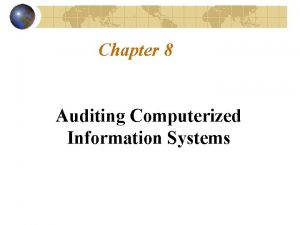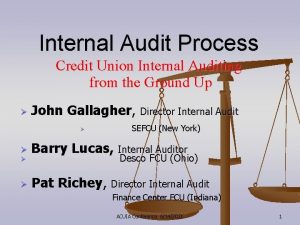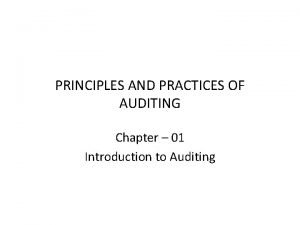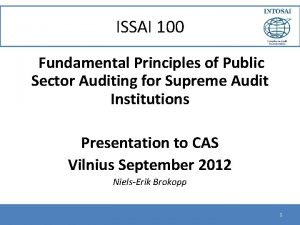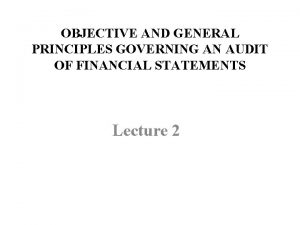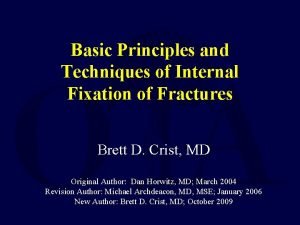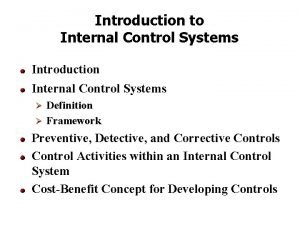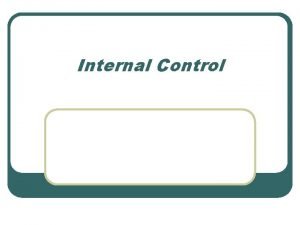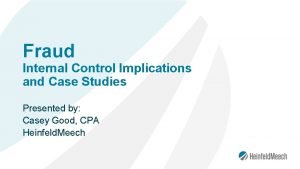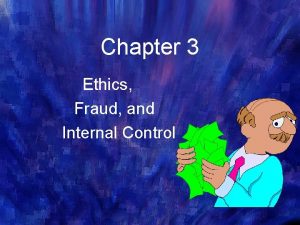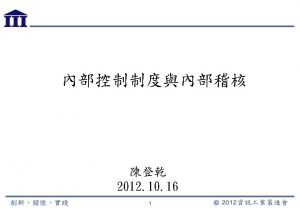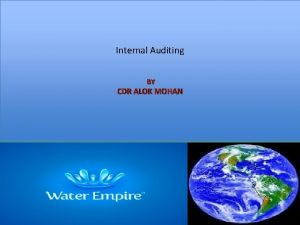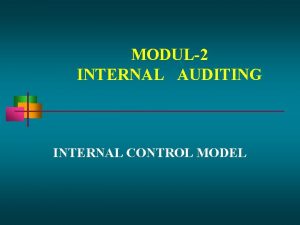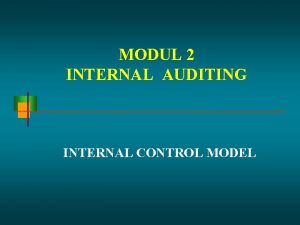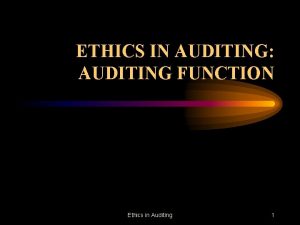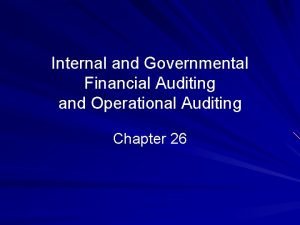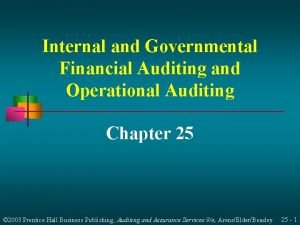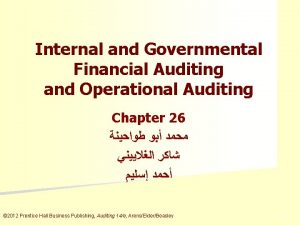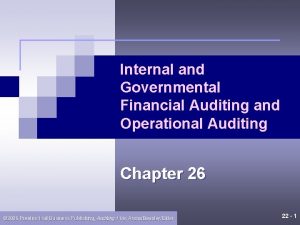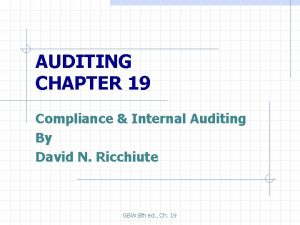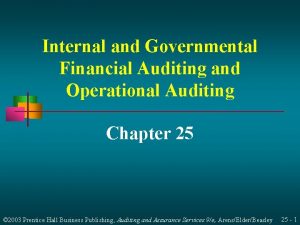PRINCIPLES OF UNIT II AUDITING AUDITING INTERNAL CONTROL



















- Slides: 19

PRINCIPLES OF UNIT II AUDITING

AUDITING - INTERNAL CONTROL Internal Control system is one of the basic and essential factors for efficient and effective management. It covers the whole management system of an organization, both financial or non-financial. Internal control system is helpful for the management and also the Auditor in achieving goals and targets effectively. Therefore, internal control system covers a number of checks and control to ensure efficient and economic working.

What is Internal Control? Internal Control comprises of the plan of the organization and all the co-ordinate methods and measures adopted within a business to safeguard its assets, check the accuracy and reliability of its accounting data to promote operational efficiency and to encourage adherence to prescribed managerial policies.

CHARACTERISTICS OF INTERNAL CONTROL ØCompetent and trustworthy personnel ØRecords, Financial and other Organization plan ØOrganizational plans ØSegregation of duties ØSupervision ØAuthorization ØSound practice ØInternal Audit ØArithmetic and accounting controls

INTERNAL CONTROL AND AUDITOR An Auditor should ensure that certain rules and procedures are followed by the business unit he is working on, in spite of the fact that a sound system of internal control is as sole responsibility of the management. The Auditor can simply guide or help the management if he is asked to do so, because he has no authority to prescribe such rules and procedures. The degree of reliance on the system depends upon the effectiveness of internal control system; therefore, the Auditor should review and evaluate the internal control system of an organization to prepare his audit Program.

INTERNAL CHECK Internal Check is an integral function of the internal control system. It is an arrangement of duties of the staff members in such a way that the work performed by one person is automatically and independently checked by the other.

OBJECTIVES OF INTERNAL CHECK Following are the main objectives of Internal Check − ØTo protect business from carelessness, inefficiency and fraud. ØTo ensure and produce adequate and reliable accounting information. ØTo keep moral pressure over staff. ØTo minimize the chances of errors and frauds and to detect them easily on early stage if it is committed. ØTo divide the work in such a way that no business transaction should be left unrecorded. ØTo fix the responsibility of every clerk according to the division of work.

INTERNAL CHECK AND AUDITOR The nature and extent of the scope of the Auditor’s work depends upon the system of Internal Check in an organization. The system of Internal Check will determine the reliability on work which an Auditor can place. The External Auditor is ultimately responsible for the final accounts. The Internal Check system cannot relieve the Auditor of his contractual responsibilities in case anything goes wrong in the final accounts, therefore it is the duty of the Auditor to check the whole transaction in detail. A good Internal Check system may relieve the Auditor of detailed checking and he can utilize the saved time to any other work of more importance.

AUDIT NOTE BOOK A note book which is prepared by the audit staff to note down all the uncleared queries which s/he may find in the course of audit and requires further clarification and explanation is known as audit note book. Audit note book contains information regarding day-to-day work performed by the audit staff on any particular date. Notes about all types of errors, difficulties and uncleared queries or points to be discussed with the auditor or clients and the points which are to be incorporate in the report are noted down.

Generally the following information is incorporated in audit note book: 1. The nature of the business carried on and the important documents relating to the constitution of the business, i. e. Memorandum Of Association, Articles Of Association ( in the case of limited companies) and Partnership Deed ( in the case of partnership firm) and other legal documents. 2. The name of the client and the audit year. 3. A list of books of accounts in use. 4. Names of principal officers, their duties and responsibilities. 5. Particulars of the accounting and financial system followed and the internal check in operation in the business. 6. Details regarding accounting and financial policies followed in the business. 7. A copy of the audit program.

AUDIT WORKING PAPERS Audit working papers are the documents which record all audit evidence obtained during financial statements auditing, internal management auditing, information systems auditing, and investigations. Audit working papers are used to support the audit work done in order to provide the assurance that the audit was performed in accordance with the relevant auditing standards. They show the audit was: ØProperly planned; ØCarried out properly ØThere was adequate supervision; ØThat the appropriate review was undertaken; & finally and most importantly; ØThat the evidence is sufficient and appropriate to support the audit opinion.

PROPER FEATURES OR PURPOSE OF WORKING PAPERS §Reviewed by auditors with supervisors noted. §Signed, dated and approved by relevant level of audit staff with sufficient cross reference. §With evidence of effective audit planning, work done, sufficient and quality evidence. §Outstanding matters are cleared in due course. There a number of companies who offer electronic working paper tools for accountants. The leading providers include: ACL, Wolters Kluwer, Case. Ware, Thomson, Data Prime Solutions, Work. Papers. Pro and Saltlake Infosolutions. Their products are ACL GRC, Team. Mate, Case. Ware Working Papers, Engagement CS, Draftworx, Work. Papers and APEX Audit System respectively.

Audit Working Paper Format. The diversity of audit assignment prevents the establishment of a single system or design of working papers to be used. Therefore, a uniform working paper format may not be used but work papers for functional areas such as cash receipts should display conformity in various types of audits. Work papers may be in the form of paper, tapes, diskettes, films, etc. There should be backup copies of electronically generated working papers. The backup copies should not be stored with the original copies.

IMPERSONAL LEDGERS Impersonal ledgers are also called General Ledgers or Nominal Ledgers. They are of two types such as Nominal Accounts and Real Accounts. Nominal accounts are related to Trading and Profit A Loss Accounts whereas real accounts record assets. If these accounts are not correct, they will affect the Profit and Loss Account and the Balance Sheet. Therefore, the auditor should vouch the items appearing in the impersonal ledgers thoroughly so that the chances of manipulation by fictitious entries of expenses can be eliminated.

HOW ARE IMPERSONAL LEDGER VOUCHED? 1. The postings of cash transactions to the Impersonal Ledger should be carefully checked. 2. The Journal should be carefully vouched to ensure that each entry is supported by sufficient evidence. 3. The auditor should carefully check the totals of the various other books of original entry and the postings thereof to the Impersonal Ledger. 4. Sometimes direct entries are passed from one account to another in the Impersonal Ledger. In such a case the auditor should vouch them in the manner in which he examines those items, which pass through the Journal.

5. He should check very carefully the adjustments, which are usually done at the end of the year when the final accounts are prepared. Such adjustments include outstanding assets and liabilities, depreciation, etc. As these adjustments pass through the Journal, their postings to the Impersonal Ledger should be checked. Special attention should be paid to these adjustments because they ultimately affect the position reflected by the final accounts. 6. The total of the subsidiary books should be checked. 7. The balances in the Impersonal Ledger should be checked and verified with the Trial Balance.

AUDIT VOUCHING Accounting entries made in the books must be supported by documentary evidence and inspection of that evidence is called vouching. The Auditor judges the authenticity, of the accounting entries using the technique of vouching. In case of unavailability of proper supporting documents, the Auditor may have all reasons to doubt about errors or fraud or manipulation. Thus, auditing is incomplete without vouching. In auditing process, based on evidence, there are two main functions collection of evidences − through observation, confirmation, inspection, inquiry. evaluation of evidences − with relevance, adequacy and validity.

Objective of Vouching Following are the main objectives of vouching − üTo check whether all the business transactions are properly recorded in the books of accounts or not. üTo see whether recorded transactions are duly supported by documentary evidence or not. üTo verify that all the documentary evidence is authenticated and related to business transactions only. üTo verify that transactions are free from errors or frauds. üTo verify whether voucher is processed through all the stages of Internal Check system properly. üTo verify and confirm that the entries are recorded according to the capital and the revenue nature or not. üTo check the accuracy of accounting transactions.

Types of Voucher There are two types of vouchers − Primary Voucher − Original copy of written supporting document is called primary voucher. Like purchase Bill, cash memo, pay-in-slip, etc. Collateral Voucher − Copies of supporting documents which are not available in original are collateral voucher like duplicate or carbon copy of sale invoice.
 Auditing standards differ from auditing procedures
Auditing standards differ from auditing procedures Parallel simulation audit
Parallel simulation audit System of internal controls
System of internal controls Audit report of a company
Audit report of a company Internal auditing assurance & advisory services
Internal auditing assurance & advisory services Credit union internal auditing services
Credit union internal auditing services Secondary objective of auditing
Secondary objective of auditing Principles of public sector auditing
Principles of public sector auditing Site:slidetodoc.com
Site:slidetodoc.com Unit 10, unit 10 review tests, unit 10 general test
Unit 10, unit 10 review tests, unit 10 general test Antiglide plate principle
Antiglide plate principle Why imprisonment acts as an external form of social control
Why imprisonment acts as an external form of social control Characteristics of social control
Characteristics of social control Scope of internal control
Scope of internal control Internal quality control in blood bank
Internal quality control in blood bank Internal control introduction
Internal control introduction Information processing objectives cavr
Information processing objectives cavr Internal control structure
Internal control structure Internal controls case study examples
Internal controls case study examples Internal control shield
Internal control shield

